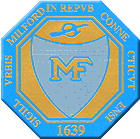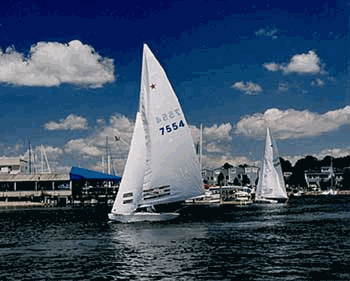About Milford
About the City of Milford
Welcome to Milford, "A Small City with a Big Heart!" Strolling through downtown you get that small town feeling coupled with the charm and the sense of history of an English settlement dating from 1639. Walk over the Hotchkiss Bridge, gaze at the gorge framed by the arch of the Memorial Bridge, stop for an ice cream cone, and rent a bike and tour, then return to have a lobster dinner. Or you might opt for a romantic Victorian setting at a classic New England Inn.
Seventeen miles of Long Island Sound coastline funnel into our harbor that winds its way to meet the Wepawaug River in the heart of town. The sixth oldest town in Connecticut, 50,000 residents are proud to boast of a meticulously maintained "town green", the second longest in New England. Multiple memorials in honor of those who have served in past conflicts parade down the grassway. A memorial bridge provides a stone passageway of history of our ancestors.
A feeling of "Milford Pride", along with ample cultural, recreational, educational and employment opportunities make the City more than just a great place to visit. Many high quality arts and crafts shows, varied festivals and events make Milford a destination for daytrippers. Water recreation abounds with access from boat launches, the Milford Lisman Landing Marina, multiple city beaches, and Silver Sands State Park. The Connecticut Audubon Coastal Center at Milford Point offers views of the estuary and Long Island Sound and their inhabitants and an educational program to explain all. The new architecturally awarded addition to Milford Hospital provides for health care needs as it has for the last 80 years.
Rounding out our unparalleled quality of life is a strong retail community that provides shoppers with all aspects of consumer goods. From the mall to the varied and diverse shopping opportunities of our small retailers-we sell it all. Boasting an ever-expanding automobile row, furniture stores, specialty shops, restaurants and hotels, ready to fulfill all types of consumer requirements.
A diversified economy supports manufacturing, retail, corporate office, and a service industry. Unemployment is at an all-time low. Home to manufacturers of consumer products, fabricated metals, plastics, as well as dot.com, investment, and hi-tech firms, Milford welcomes all to its corporate, research and industrial parks.
Milford History
February 1, 1639, is the date the area then known as "Wepawaug" was purchased from Ansantawae, chief sachem of the Paugusset Tribe. Settlers began arriving shortly thereafter and began to build the town known as Milford. Townspeople played a part in the development of the United States. Adventurers from Milford reached out and founded several other communities and explored afar.
Buried treasure is said to exist on a small island the Indians called "Poquahaug", just a mile off Silver Sands Beach. It is a recognized fact that Captain Kidd and other pirates sailed and hid along the Connecticut coast. It’s no wonder that iron chests filled with "loot" are rumored to be buried on the land called Charles Island!
Three governors of Connecticut called Milford their home. Fort Trumbull was built to provide protection in the late 1700s during the Revolutionary War. Yes, George Washington dined and rested here! During the Civil War, Milford was a stop on the Underground Railroad. Although primarily agrarian, shipbuilding, oystering, small industry and trade on the open seas from the harbor were part of the local economy. The early 1900's brought the leather industry along with the making of boots, hats and shoes. Milford was also famous for carriages, which were sold throughout the centuries.
After World War II, the population swelled as GIs returned from the war and bought houses in the suburb of New Haven and Bridgeport called Milford. Industry also developed to support the war effort. Norden, Milford Rivet, U.S. Motors, and Edgecomb Steel were some of the familiar names of the time. Other industry followed most notably the consumer giants of Bic and Schick. Then the completion of I-95 in 1960, with its seven exits and entrances brought easy access. The Connecticut Post Shopping Center and other development followed rapidly. Development reached a peak in the 70s and 80s, leveled off in the early 90s and then picked up again in the late 90s until we reached our present population of over 52,000 and businesses that number over 2,000.
The Milford Historical Society safeguards three 18th century homes at its Wharf Lane Complex. Among their possessions is one of the finest collections of Native American artifacts.
Evolution of the Milford Seal

February 12, 1639
Founding of colony called Wepowage, the Indian name for the river that flowed through the settlement.
November 24, 1640
The General Court voted to change the name to Milford and adopted the letters MF as the official seal.
June 19, 1916
Voters, in a Town Meeting, adopted the Seal of the Town of Milford; an emblem in the shape of an octagon, in the center of which there shall be a shield bearing the letters MF, being the Seal adopted by the original settlers...In the strap of the octagon the following Latin words to appear:;Sigill Oppidi Milford in Repub Connecticutensi (Seal of the Town of Milford in the Republic of Connecticut) also the date 1639, and the bow and arrow of Ansantawae.
The octagonal shape honors Robert Treat of Milford who served Connecticut for 32 years as Deputy Governor and Governor and whose personal seal was of that form. He was also Milford's first Town Clerk.
The bow and arrow are in memory of Paugusset Indian Sachem Ansantawae who drew them as his mark on the deed for the sale of the land to the settlers in 1639.
November 4, 1959
Electors voted to change from a Town Government to a City Government, consequently, the Latin wording in the octagon became Sigill Urbis Milford in Repub Connecticutensi (Seal of the City of Milford in the Republic of Connecticut).


